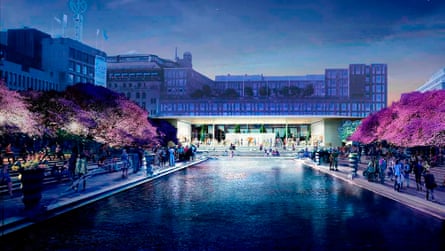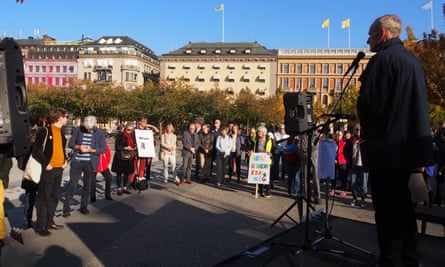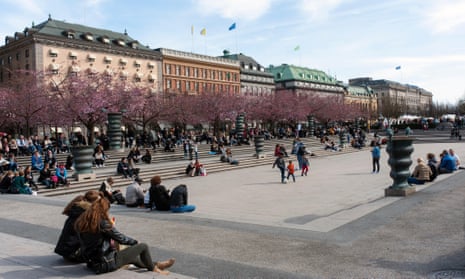In the pictures, it looks lovely. Young urbanites mingle around cafe tables outside a glass facade running almost the whole width of a park, topped off with a sliver of roof that tapers at the edges like the lid of a MacBook Air computer.
Which modern capital would not scream to have this Foster + Partners-designed Apple store in pride of place in its city centre?
Well, Stockholm, apparently. On the day it took power earlier this month, the Swedish capital’s new government announced that it would block the project in Kungsträdgården park.
“It is welcome that Apple wants to establish itself in the city,” says Erik Slottner, the Christian Democrat politician who has led political opposition to the building. “But Kungsträdgården is the wrong place.”

To many in the city, it seems astonishing that the company could ever have thought Kungsträdgården – the King’s Garden – an appropriate place for a store, however outstanding its design. The park looks over the water to the Royal Palace, connecting the city to the monarchy in the same way that the Mall in London links to Buckingham Palace. It is one of the city’s oldest parks, the venue for public events from Pride parades to election debates, political protests to winter ice-skating.
“Kungsträdgården is the most important park in Sweden,” says Johanna Jarméus of Nyréns Arkitektkontor, a leading architecture firm. “It is the thread that pulls together the historical power of the monarchy with the commercial blocks of Hamngatan and the working-class districts of Södermalm. This is very important for democracy because it has to do with power, symbolically and spatially.”
Opposition came not only from protesters and conservationists, but from official bodies such as the city’s official Beauty Council. There were around 1,800 responses to the city’s consultation on the project. Almost all of them were negative.
“Apple must have had very bad advisers,” says Göran Folin, whose green pressure group Alternativ Stad – the Stockholm branch of Friends of the Earth – led the grassroots opposition, handing out leaflets and putting up posters in the park this summer. “When I heard about it, I thought it must be impossible. Stockholmers won’t let them build a big store in Kungsträdgården. City parks are a little bit holy in Stockholm. You can’t privatise a park.”

But the retail strategy Apple announced last year suggests that it was no misjudgment: blurring the boundaries between public and private space is exactly what the company is trying to do.
“It’s funny, we actually don’t call them stores anymore,” Angela Ahrendts, Apple’s senior vice-president of retail, said in November last year, a sentiment reiterated at Apple’s new product event on Tuesday. “We call them town squares, because they’re gathering places where everyone is welcome.”
Stockholm is the first city to frustrate the new strategy, but Melbourne, Australia, is close behind. Approximately 30,000 people have signed a petition protesting against the company’s plans to take over the southern side of the city’s Federation Square. A temporary heritage order has blocked the planned store until December, and the square could soon get permanent protection.
Earlier in October, Google shelved its plans to open a campus in Kreuzberg, a bohemian area of Berlin, backing down in the face of an energetic anti-Google campaign.

In Stockholm and Melbourne, what disturbed many about Apple’s plans was the way the designs, both by Foster + Partners, reached out over the adjoining public space. The Stockholm store’s design gives it the feel of a futuristic Renaissance palace, with the entire park as its formal garden.
“Apple’s store places itself on a podium on the park’s central axis and dominates the setting, seen from the park,” Nyréns wrote in its response to the consultation. “The building, with its location and size, stakes a claim to be the park’s main building.”
“It takes all its energy and all its aura from the public space and doesn’t add anything,” says Dan Hallemar, editor of Arkitektur, Sweden’s leading architecture magazine. “It’s like a parasite.”
As in Melbourne, Apple’s proposal for Kungsträdgården involves funnelling public space into private hands, with the company hoping to annex 375 square metres of parkland around the plot to which it had bought building rights.
The plot, which now houses an unprepossessing branch of the US chain TGI Fridays, is open to private developers on the condition they use it for restaurants and cafes that serve the park. Apple’s plan would see it rezoned for retail.

“What the city is doing when discussing the idea with Apple is to sell public park space, a scarcity in central Stockholm, to private business,” Jarméus says. “We don’t understand why the city would do a thing like that.”
The story may not be over yet: Apple still owns the rights to the plot. The company’s lobbyist, Anders Johansson, is married to Ulrica Schenström, once a special advisor to former Swedish prime minister Fredrik Reinfeldt – whose Moderate party is providing the incoming vice-mayor for city planning.
Björn Ljung, who leads the Liberal party in the new city government, hopes “something more public” will replace TGI Fridays.
“If we could do something radical, it would be to open all the area from Hamngatan into Kungsträdgården, and not have anything in its place at all,” he says. But that would mean buying Apple out.
After the new government’s announcement, a planned protest by group Alternative Stad was changed to a victory celebration, with performances from singer-songwriters and poets.

“The atmosphere was really nice,” says Stefan Korpar, 30, who gave a rendition of a punk song from 1982 about demolishing “Stockholm’s heart”. “It was park life as it should be — not yet destroyed by the Apple building.”
Several there, including the 79-year-old Folin, were veterans of the 1971 Almstriden, or Elm War, when demonstrators camped out at the waterside end of the park to protect 13 trees the city government wanted to tear down.
Hallemar, the editor of Arkitektur, hopes that, just as the Elm War brought an end to the heedless destruction of Stockholm’s historical centre, the battle with Apple will mark a turning point.
“For the last 20 years, there’s been this story in Stockholm that the interests of the private sector and the public are the same; that there’s no conflict between a public space and a private space,” he says. “This Apple store is interesting because it has shown the naivety of this idea. It’s so obvious now for anyone who looks at it that the public space isn’t for us – it’s for a billion dollar brand.”
Follow Guardian Cities on Twitter, Facebook and Instagram to join the discussion, and explore our archive here

Comments (…)
Sign in or create your Guardian account to join the discussion